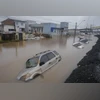Erratic weather and unpredictable rains have become the new normal. And due to these extreme weather events, flood insurance is emerging as a critical tool. It offers financial assistance in case of damages to households and businesses.
Understanding flood insurance
Flood insurance is a distinct type of property insurance that shields homes and their contents from losses resulting from flooding. This coverage can protect against a range of flood-inducing events, including heavy rainfall, overflowing water bodies, hurricane storm surges, and infrastructure failures like dam or levee breaches.
Unlike standard homeowners policies, which may cover water damage from burst pipes or storms, flood insurance specifically addresses damage caused by rising floodwaters.
Types of flood insurance
More From This Section
Flood coverage is typically available as an add-on to standard property insurance policies.
There are two main types:
Structure coverage: This protects the building itself, including walls, floors, built-in appliances, and electrical systems.
Contents coverage: This covers personal belongings, furniture, and other items within the property.
Benefits of flood insurance
One of the main advantages of having flood insurance is the financial protection it provides. Damages done by flooding can be incredibly costly to mend, often exceeding the capacity of personal savings or government aid. A flood insurance policy can help cover these expenses, allowing property owners to restore their homes or businesses more quickly.
Another key benefit is the peace of mind that comes with knowing you are protected. Floods can happen anywhere, and even properties located in low-risk areas are not immune to the devastating effects. Having a flood insurance policy in place provides a sense of security and helps alleviate the stress and uncertainty that often accompanies a flood event.
What are the factors that determine the premium of flood insurance?
The cost of your insurance policy depends on the specific protections you choose, so premiums can vary from person to person. The location of your home also plays a big role. If you live in an area prone to floods, your premium will be higher. Additionally, the structural integrity of your house and your history of past claims also play crucial roles in determining the premium.
“Flood insurance is a part of home insurance that covers both property and material damage. It also includes a sub-part of motor insurance, extending coverage for vehicles and crucial components. Besides base coverage, individuals residing in flood-prone areas are advised to explore add-ons such as engine and gearbox protection covers, roadside assistance covers, and return-to-invoice covers,” said Praveen Chaturvedi, General Manager- General Insurance at Insurance Samadhan.

)